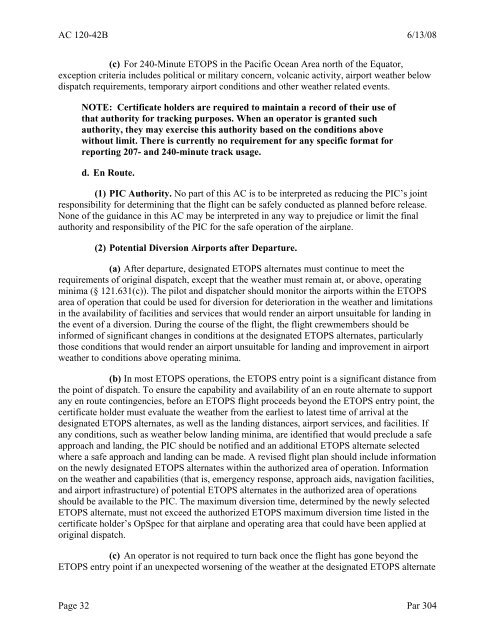AC 120-42B ETOPS and Polar Ops - Code7700
AC 120-42B ETOPS and Polar Ops - Code7700
AC 120-42B ETOPS and Polar Ops - Code7700
You also want an ePaper? Increase the reach of your titles
YUMPU automatically turns print PDFs into web optimized ePapers that Google loves.
<strong>AC</strong> <strong>120</strong>-<strong>42B</strong> 6/13/08(c) For 240-Minute <strong>ETOPS</strong> in the Pacific Ocean Area north of the Equator,exception criteria includes political or military concern, volcanic activity, airport weather belowdispatch requirements, temporary airport conditions <strong>and</strong> other weather related events.NOTE: Certificate holders are required to maintain a record of their use ofthat authority for tracking purposes. When an operator is granted suchauthority, they may exercise this authority based on the conditions abovewithout limit. There is currently no requirement for any specific format forreporting 207- <strong>and</strong> 240-minute track usage.d. En Route.(1) PIC Authority. No part of this <strong>AC</strong> is to be interpreted as reducing the PIC’s jointresponsibility for determining that the flight can be safely conducted as planned before release.None of the guidance in this <strong>AC</strong> may be interpreted in any way to prejudice or limit the finalauthority <strong>and</strong> responsibility of the PIC for the safe operation of the airplane.(2) Potential Diversion Airports after Departure.(a) After departure, designated <strong>ETOPS</strong> alternates must continue to meet therequirements of original dispatch, except that the weather must remain at, or above, operatingminima (§ 121.631(c)). The pilot <strong>and</strong> dispatcher should monitor the airports within the <strong>ETOPS</strong>area of operation that could be used for diversion for deterioration in the weather <strong>and</strong> limitationsin the availability of facilities <strong>and</strong> services that would render an airport unsuitable for l<strong>and</strong>ing inthe event of a diversion. During the course of the flight, the flight crewmembers should beinformed of significant changes in conditions at the designated <strong>ETOPS</strong> alternates, particularlythose conditions that would render an airport unsuitable for l<strong>and</strong>ing <strong>and</strong> improvement in airportweather to conditions above operating minima.(b) In most <strong>ETOPS</strong> operations, the <strong>ETOPS</strong> entry point is a significant distance fromthe point of dispatch. To ensure the capability <strong>and</strong> availability of an en route alternate to supportany en route contingencies, before an <strong>ETOPS</strong> flight proceeds beyond the <strong>ETOPS</strong> entry point, thecertificate holder must evaluate the weather from the earliest to latest time of arrival at thedesignated <strong>ETOPS</strong> alternates, as well as the l<strong>and</strong>ing distances, airport services, <strong>and</strong> facilities. Ifany conditions, such as weather below l<strong>and</strong>ing minima, are identified that would preclude a safeapproach <strong>and</strong> l<strong>and</strong>ing, the PIC should be notified <strong>and</strong> an additional <strong>ETOPS</strong> alternate selectedwhere a safe approach <strong>and</strong> l<strong>and</strong>ing can be made. A revised flight plan should include informationon the newly designated <strong>ETOPS</strong> alternates within the authorized area of operation. Informationon the weather <strong>and</strong> capabilities (that is, emergency response, approach aids, navigation facilities,<strong>and</strong> airport infrastructure) of potential <strong>ETOPS</strong> alternates in the authorized area of operationsshould be available to the PIC. The maximum diversion time, determined by the newly selected<strong>ETOPS</strong> alternate, must not exceed the authorized <strong>ETOPS</strong> maximum diversion time listed in thecertificate holder’s OpSpec for that airplane <strong>and</strong> operating area that could have been applied atoriginal dispatch.(c) An operator is not required to turn back once the flight has gone beyond the<strong>ETOPS</strong> entry point if an unexpected worsening of the weather at the designated <strong>ETOPS</strong> alternatePage 32 Par 304
















